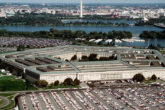September 17, 2018
The Pentagon must modernize before it’s too late
For the first time since the end of the Cold War, the Pentagon has a genuinely new strategy: Focus on our rivals — Russia and, in particular, China — and maintain a competitive advantage over them. Defense Secretary Jim Mattis warns in his 2018 National Defense Strategy that if we fail to do so, we may lose the next big war against these nations. If that happens, say goodbye to the free and open international order the United States has built and upheld since the 1940s.
So will the Defense Department take the big steps needed to implement this strategy? That’s the key question — and this is a key moment. That’s because, earlier this year, Congress gave the Defense Department its largest budget increase since 2001 — a 10 percent raise, after inflation. In return, the Pentagon must show meaningful progress in realizing this strategy.
And it needs to do it in a hurry. China and Russia have spent decades building militaries specifically designed to fight and beat ours. Meanwhile, we have focused on rogue states and terrorism, taken a largely business-as-usual approach to modernization, and robbed the Peter of advanced capabilities to pay the Paul of day-to-day force employment. This route, as the strategy makes clear, is a losing proposition.
We need not just modernization in general terms, but also modernization and advanced capabilities designed to defeat Russia or China’s theories of victory. They’ve spent years working to undermine our successful Desert Storm approach and have basically cracked the code. Now it is time for us to turn the tables — before we lose our edge.
That requires major change in what we buy, how the force fights and how we integrate with allies and partners. The operational concepts that worked against Iraq in 1991 must be left in the past. We need to move away from the large and vulnerable ships, the fixed bases, and the short-range aircraft and munitions upon which we have long relied. We need to revamp our space, logistics and cyber architecture. And we need to rethink military plans that focus on establishing dominance in every domain before pushing the enemy back.
Read the full op-ed in The Washington Post
More from CNAS
-
Lessons in Learning
Executive Summary Although claims of a revolution in military affairs may be overhyped, the potential for artificial intelligence (AI) and autonomy to change warfare is growin...
By Josh Wallin
-
The Pentagon Push to Change an “Antiquated” System
Carlton Haelig, a fellow at the Center for a New American Security, joined The Cipher Brief to discuss the systems in place in the Department of Defense and the challenges ass...
By Carlton Haelig
-
The Department of Defense’s Breakthrough Nuclear Moment Risks Slipping Away
Unless they act, the Department of Defense’s breakthrough nuclear moment may vanish before it really happens....
By Will Rogers
-
DEFAERO Strategy Series [Apr 09, 25] CNAS' Becca Wasser and Phil Sheers on Revitalizing the U.S. Defense Industrial Base
On this episode of the Defense & Aerospace Report Strategy Series, sponsored by General Atomics Aeronautical Systems, Becca Wasser and Phil Sheers of the Center for a New Amer...
By Becca Wasser & Philip Sheers




